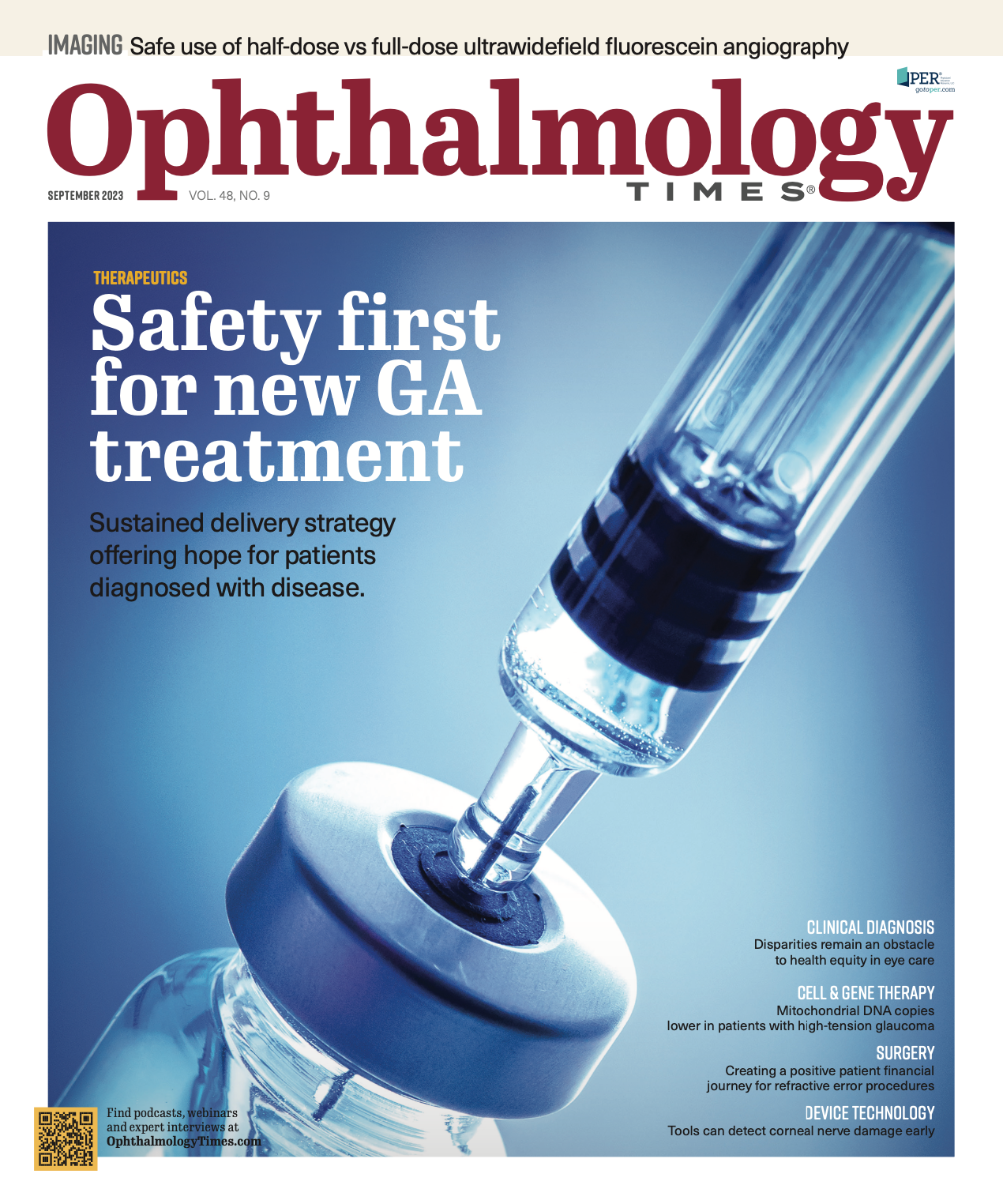Publication
Article
Digital Edition
Safety first for new GA treatment
Author(s):
Sustained delivery strategy is offering hope for patients diagnosed with the disease.
(Image Credit: AdobeStock/PhotobyTawat)

Reviewed by Pravin U. Dugel, MD
The FDA has approved avacincaptad pegol intravitreal solution (Izervay; Iveric Bio) for the treatment of geographic atrophy (GA) secondary to age-related macular degeneration (AMD). The approval is the second for a drug for GA, following pegcetacoplan injection (Syfovre, Apellis Pharmaceuticals) in February 2023.
In July 2023, Astellas Pharma completed its $5.9 billion acquisition of Iveric Bio.
Pravin U. Dugel, MD, president of Iveric Bio, an Astellas company, noted in an interview with Ophthalmology Times the company was pleased to receive the FDA’s nod for avacincaptad pegol intravitreal solution.
"On a personal note, macular degeneration runs in my family,” Dugel told Ophthalmology Times. “So from my perspective, I know the impact that it has on patients, but I also know the impact that it has on families.”
Citing drug's potential
Dugel also cited the potential to have another drug in the market that has “solid scientific data, the only drug that has 2 positive phase 3 studies which met the primary endpoints.” The trials, according to the company, are GATHER1 (NCT02686658) and GATHER2 (NCT04435366), both randomized, double-masked, sham-controlled, multicenter, phase 3 trials.
To understand how the drug, a C5 inhibitor, works, Dugel said it is important to understand the pathogenesis of macular degeneration.
“In my early years of practice, we thought of macular degeneration as a binary event,” he explained. “We found that when [individuals] got old, they got to a fork in the road where they had macular degeneration and either it was wet or dry. That’s the fork in the road, and that was it. Maybe the most profound change in our scientific understanding of macular degeneration in the [past] decade has been that there is no fork in the road. It’s a singular highway that starts out with waste products that we call drusen, which appear to be in some patients in their 40s and progresses all the way to geographic atrophy.”
In a wound healing process, there is an interplay between angiogenesis and inflammation. For example, a paper cut in the finger results in swelling, redness, and blood. This occurs because blood vessels are dilating. Blood vessels are being built so that inflammatory cells can go to the target. So, this interplay between angiogenesis and inflammation is absolute.
Dugel said, in the context of disease progression, “the anti-VEGF [therapies] have been wonderful, but what they do is put patients back into the highway. How do we know that? Well, we know that at the end of the day, when patients are being treated with the anti-VEGFs, they end up going blind.”
Avacincaptad pegol intravitreal solution may address the component of inflammation in the wound healing process, which is initiated by complement activation. “The complement pathway is terribly important for us because that’s what allows us to fight against intrinsic and extrinsic pathogens, so it’s very important on the one hand to moderate it but on the other hand to keep it alive,” he said.
There is no animal model for macular degeneration; Dugel noted investigators relied on the human trials.
“So, if you look at our efficacy profile there’s an early separation between treatment and sham." he said.
Moreover, Dugel noted he had concerns that with GA and complement inhibition, treatment may be too late. He pointed out that a goal is to have version 2 and, potentially, version 3 for earlier treatment of intermediate macular degeneration.
“Now it’s not sustainable in the form that it is now when you have early macular degeneration to have people come in on a monthly basis,” he said. “But it will be sustainable if you have a sustained delivery device, for instance, where you may have to come in only once every 6 months or once a year, as you would go for teeth cleaning. I think, ultimately, this disease is going to be a spectacular example of treatment and avoidance of blindness.”
Across the GATHER clinical trial program, the most common adverse reactions reported at 12 months were conjunctival hemorrhage, intraocular pressure, and blurred vision. Dugel noted that the clinical trials had no reported cases of retinal vasculitis, retinal occlusive vasculitis or hemorrhagic occlusive retinal vasculitis.
Izervay, according to Dugel, is administered in a 100-µL injection using a 30-gauge needle, and the viscosity is similar to that of anti-VEGF treatments.
“The actual procedure is going to be very, very familiar for retina specialists as well as for some patients,” he explained.
Dugel siad avacincaptad pegol intravitreal injection is priced at $2100, which he said is competitive.
“You will also be hearing details very soon about different programs to help ensure access and affordability for eligible patients we want to make sure that people who need this have access to it,” he explained.
Dugel said there are different plans outside the United States. “In the [United States], we are absolutely prepared with the payers, we’re prepared with the physicians, we’re prepared with a referral network to make sure that this launches immediately,” he said. “This has been done by our team many times before with the anti-VEGF.” Dugel noted Iveric Bio was recently acquired by Astellas, which will provide additional resources as the company irons out potential approvals outside the United States.
Arshad M. Khanani, MD, MA, FASRS, director of clinical research at Sierra Eye Associates, Reno, Nevada, lauded the opportunity afforded by avacincaptad pegol intravitreal solution.
“Geographic atrophy has a devastating impact on patients’ lives and can lead to irreversible vision loss,” Khanani said in a separate interview. “As a C5 inhibitor, Izervay has been shown to slow GA progression by targeting the source of retinal cell death and may preserve the upstream benefits of the complement system. The FDA approval of Izervay is great news for the retina community and our patients suffering from GA.”
About GATHER
GATHER1, a randomly assigned, double-masked, phase 2/3 clinical trial, examined the different doses of avacincaptad pegol intravitreal solution and compared the treatment to a sham injection.
“It met the primary end point where the slowdown of GA in patients treated with Izervay was significant compared to patients who are treated with sham,” Khanani said in the interview. “We saw an effect that was obvious early in the treatment course, and it increased over time. The primary end point was at 12 months, and the trial met statistically significant P value.”
Khanani noted the recently published extension GATHER1 data from 12 to 18 months demonstrated continuous benefit of patients who are treated with avacincaptad pegol intravitreal solution. GATHER1 was followed by the global, double-masked, randomly assigned GATHER2. In that study, patients were treated with 2 mg of avacincaptad pegol intravitreal solution.
“That was the dose that was found to be optimal in terms of efficacy and safety in GATHER1,” he said. “Here, patients were [randomly assigned] to either receive Izervay 2 mg or sham injections every month. The primary end point was, again, at 12 months looking at reduction in the GA progression or growth rate in the treated arm compared to sham.”
Khanani noted both trials demonstrated there was no clinically significant inflammation, and just 1 case of asymptomatic vitreous cells in GATHER1 that resolved without treatment.
“Looking at onset of neovascular AMD, what we have seen is that in multiple complement inhibitor trials, we have seen an increased rate of neovascular wet AMD,” Khanani said. “In patients who are treated with complement inhibitors, we’re still trying to understand why it happens. It could be a response from the body to slow down GA, but we still don’t know.”
Khanani pointed out the clinical trial demonstrated a 7% rate of neovascular AMD in patients, compared with 4% in the sham group survey. He noted it is a slight increase, but obviously, there are good treatment options available to treat neovascular AMD.
“The GATHER1 and GATHER2 data set is very powerful in terms of efficacy as well as safety, and that’s why it led to the approval of Izervay by the FDA,” he concluded.
Going forward, the company will work to ensure it has enough avacincaptad pegol intravitreal solution to meet demand as it rolls out the new therapeutic. Dugel noted that when anti-VEGF was introduced, demand outpaced supply.
“It can be difficult to predict demand,” he said, “when there’s no drug to treat the condition. So why would anybody bother coding or tabulating these patients? We expect the same thing here. We expect the actual demand to be far, far more than what the numbers would show for the same reasons.”
Dugel also noted that the company has done all it can to ensure it is prepared for the anticipated demand.
“We have a very large inventory, and we’ve got 2 places that will make API for us,” he concluded. “We are very confident that we will be able to supply all of the patients who need this drug.”

Newsletter
Don’t miss out—get Ophthalmology Times updates on the latest clinical advancements and expert interviews, straight to your inbox.





